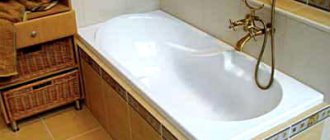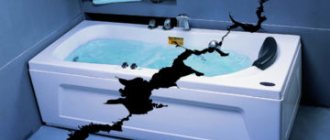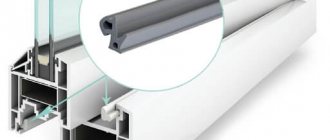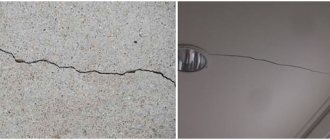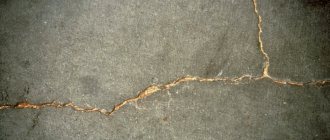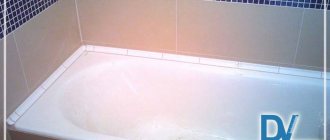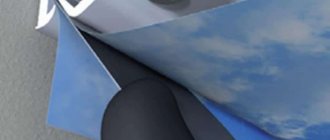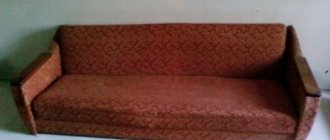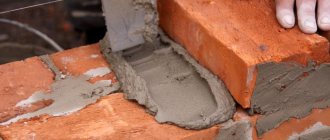In our article we will talk about the types of damage to plastic bumpers, what materials bumpers are made from, the properties of these materials, we will describe all the main methods of repairing plastic bumpers, and we will provide step-by-step instructions for performing repair work.
Types of damage to plastic bumpers
Scratches
Scratches are non-through damage to the bumper surface in the form of grooves. Bumper scratches are divided into two types:
- superficial scratches
- only the paintwork of the bumper up to the primer layer is damaged. - Deep scratches
- damage grooves have a significant depth, and not only the paint layer and primer layer are damaged, but also the plastic of the bumper itself.
Don't take too long to remove scratches on the bumper; over time, they can turn into cracks.
Scratches on the bumper can be removed by sanding with sandpaper or a sanding machine. The surface of the bumper is sanded until smooth, then the surface of the bumper is puttied, primed and painted.
Dents
Dents are deformations of the surface of a plastic bumper due to local stretching of the plastic. Dents are formed due to strong mechanical impact on the bumper. Dents are often accompanied by scratches and cracks.
To remove the dent, the deformed part of the bumper is heated using a hair dryer or a gas burner. When the deformed section of the bumper softens, the dent is straightened, returning the bumper to its correct shape.
Cracks
Cracks are called through damage to the bumper, having different lengths and shapes. Cracks are the most common type of bumper damage. Cracks that are not repaired in time increase in length over time due to vibration. There are different ways to repair bumper cracks: welding with a hot air gun, gluing with fiberglass and liquid polymer, soldering in a metal mesh or metal brackets with a soldering iron. The choice of repair method depends on the material from which the bumper is made and the size and appearance of the damage.
Chips
Chips are end-to-end damage to the bumper with separation of individual fragments from the bumper. Chips most often appear along the edges of the bumper after a car collides with obstacles. The methods for repairing bumper chips are similar to the methods for repairing cracks.
Preparatory stage
Along with purchasing the necessary materials and tools, during the preparation process you need to carry out certain work on the bumper itself. Among the most important points are:
- Removing the bumper from the car body.
- Thoroughly clean the part from dirt and dust. The surface must be dry and clean.
- Determining the material from which the bumper is made.
- In areas where restoration work will be carried out on the bumper, it is necessary to remove the applied paint. It is necessary to thoroughly clean and degrease not only the damaged area itself, but also the surrounding area.
- Before repairing, the crack must be drilled with small through holes at the ends. This will avoid the subsequent spread of the damage and its increase in size.
- Any crack has special joining edges. Therefore, before the crack is repaired, the joints will need to be filled with a special composite.
After completing all the above processes and manipulations, you can begin repairing the bumper yourself.
Types of bumper materials
The bumpers of modern cars can be made of different types of plastic. Before starting repairs, to choose the correct repair method, you should determine the type of plastic. The easiest way to do this is by looking at the inside of the bumper, where the type of plastic used to make the bumper should be indicated with a letter code. In the absence of markings on the back of the bumper, the type of plastic can be determined by indirect evidence by testing a broken piece of the bumper. Experienced craftsmen determine the type of plastic by appearance alone.
The main types of plastics used to make plastic bumpers are:
- PP - polypropylene
, flexible and tear-resistant, softens when heated, burns with a clear flame, blue at the base and yellow at the top, does not form soot when burning, forms drops during combustion, when burning it emits an odor reminiscent of oil or wax, does not extinguish itself, does not dissolve in acetone. It can be welded well with a hairdryer, soldered with a soldering iron, the use of reinforcing material is not necessary. When welding and soldering, it is important to observe the temperature regime. Melting temperature 300℃, welding temperature 300-340℃, destruction temperature 350-370℃. - ABS - acrylonitrile butadiene styrene
, fragile, when bent the bend turns white, burns with flashes, an orange flame, smokes heavily, quickly passes from solid to liquid, very fluid, bubbles when overheated, smells like rubber when burning, does not extinguish itself, easily dissolves in acetone. It is welded with a hairdryer, soldered with a powerful soldering iron, gas torch, and glued together. Melting temperature 350℃, welding temperature 350-370℃, destruction temperature 380-400℃. - PA - polyamide,
when bent the bend turns white, burns poorly, with a yellow flame with a blue base, melts when burning, foams, emits a pungent odor of formic acid, extinguishes itself, does not dissolve in acetone. It is welded with a hairdryer, soldered with a powerful soldering iron, gas torch, and glued together. Melting temperature 400℃, welding temperature 400-440℃, destruction temperature 450-470℃. - PUR - polyurethane,
difficult to weld and solder, requires good reinforcement. It is welded with a hairdryer and soldered with a soldering iron with precise temperature control. It is important not to overheat the part. The melting point of polyurethane is 200℃. - PC - polycarbonate
, burns with a yellow flame, with flashes and flaming ash, emits a caramel smell when burning, and partially extinguishes itself. Melting temperature 350℃, welding temperature 350-370℃, destruction temperature 380-400℃. - PE - polyethylene
, burns with a clear flame, with a yellow top and blue base, forms drops during combustion and emits a smell reminiscent of stearin, does not extinguish itself. Melting point 270-300℃. - PVC - polyvinyl chloride
. It is welded with a hairdryer and soldered with a soldering iron. The seam must be reinforced due to the low strength of PVC. Melting point 300-400℃. - Fiberglass
- does not have any special markings; it is repaired by laying several layers of fiberglass cloth and impregnating it with polyester or epoxy resin.
Features of finishing
If the bumper has a faint relief or noble roughness, then sanding and polishing will completely ruin it. Such parts can only be painted.
Painted areas may look alien, even if the color is matched tone to tone. The reason for this is the microrelief of the repaired area, which has a different refractive index of light. In this case, only multi-layer continuous painting of the entire part will help.
If differences in tone are caused only by burnout of the main element, you can try to refresh it by wiping it with a cloth soaked in acetone.
The bumper does not particularly affect the driving performance of the car. Its condition largely reflects the personality of the owner and his life philosophy. However, deteriorating aerodynamics increases fuel consumption, and pieces of plastic flying off while driving can damage surrounding cars. Therefore, even inveterate “don’t care” people should think about repairing this body element.
Methods for repairing plastic bumpers
Welding a bumper with filler rods and a hair dryer
Welding a bumper using filler rods and a heat gun is the most durable way to repair plastic bumpers. During the welding process, when the filler rod and the bumper melt, a monolithic connection is obtained that is not inferior in strength to a whole bumper that has not been repaired. Welding the bumper with a hairdryer allows you to repair cracks and chips in the bumper.
For high-quality bumper welding, it is advisable to use a hair dryer (heat blower) with smooth temperature control and air supply control. For a hair dryer you will need a set of welding attachments. A welding nozzle with a nozzle with a diameter of 5-7 mm is best suited for welding plastic bumpers.
For welding plastic bumpers, special filler rods are used. Filler rods can be flat, triangular, or round in shape. The rods must be made of the same type of plastic as the bumper. If there are no rods, you can replace them with thin strips cut from another bumper, which should be made of the same plastic as the bumper of the car being repaired.
When repairing large cracks and holes, it may be necessary to use reinforcing material, which can be metal mesh or staples from a construction stapler. The mesh and staples are heated with a hairdryer and pressed into the plastic from the inside of the bumper.
When repairing a plastic bumper, heating to the required temperature is important. When heated to the plasticity temperature, the plastic can be given a certain shape and bent in the desired direction. When heated to the melting point, the plastic can be welded, connecting the parts together. When heated to the destruction temperature, the plastic hardens, but the weld contains plastic decomposition products and does not have the necessary strength.
Welding of a plastic bumper is carried out in the following order:
- the bumper is cleaned on both sides of the future weld to a width of 15 mm. The ends of the cracks are drilled to prevent their further growth. Using a Dremel with a cone attachment or a grinder, chamfer both sides of the future seam, so that a recess is formed in the form of a groove, into which the molten filler rod can then be placed.
- The crack or parts of the broken bumper are connected and fixed with special clamps, clothespin clamps or metal tape.
- Set the temperature on the hairdryer to about 300-350 degrees and warm it up for 5-10 minutes to stabilize the temperature of the hot air. At first it is better to set a lower temperature on the hair dryer, then if the rod does not melt, it is gradually increased.
- To facilitate the start of the welding process, the end of the rod must be sharpened. When welding, the rod is held at an angle of 45 degrees, pressing with force towards the seam. The hot air flow must be directed in such a way that not only the rod melts, but also the thin edges of the bumper at the seam site. The rod is melted and, under pressure, placed in the prepared groove.
- If necessary, welding can be done in two stages: first, the edges of the damaged section of the bumper are fastened using short seams (tack welds) along the entire length, then final welding is performed.
- To strengthen the weld without using reinforcing material, some craftsmen make transverse bridges from a filler rod on the inside of the bumper every 3–5 cm.
- The resulting seam should be smooth and rise above the surface to be welded. First, the bumper is welded from the inside, then from the front side.
- After welding, the bumper should cool down for 5-10 minutes; during this time, you should not check the weld for strength or make sudden movements with the bumper, all this can lead to damage to the integrity of the seam.
- After the plastic of the bumper has completely cooled, you should cut off any protruding bumps, and then sand the bumper using sandpaper.
Advice from professionals
- To restore products made of thermoactive plastic, do not use metal mesh; it is used only when gluing the bumper.
- When preparing for painting work, apply the putty in a thin layer and wait until it dries completely. When processing the surface, finish polishing with finishing sandpaper.
- Use primer before painting - two coats of primer is normal. It is necessary to paint the entire surface of the repaired bumper so that the new paint does not fall off during use.
- Do-it-yourself bumper repair is best combined with other paint work on the car in order to save money on the selection and production of paint for the car.
Any more or less prepared car enthusiast will be able to repair the bumper with his own hands, without resorting to the services of professional car services, unless, of course, the bumper is an integral part of tuning with airbrushing. In this case, you cannot do without specialists.
Repairing a bumper with your own hands or seeking the help of professionals is a personal matter for each person, which depends on the choice - to do it yourself or pay money for repairs.
Sources
- https://remontautomobilya.ru/kak-provesti-remont-plastikovogo-bampera-svoimi-rukami-vse-metody-vosstanovleniya.html
- https://1autoguide.ru/detali-kuzova/remont-bampera-avtomobilya-svoimi-rukami
- https://autoexpertjournal.ru/remont-bampera/
- https://auto-gl.ru/remont-plastmassovyh-bamperov-4-vida-povrezhdeniy-i-7-metodov-ih-ustraneniya/
- https://proautobu.ru/remont-bampera-svoimi-rukami/
- https://delairukami.ru/avto/remont_bampera/
- https://topreit.ru/ru/%D1%80%D0%B5%D0%BC%D0%BE%D0%BD%D1%82-%D0%B1%D0%B0%D0%BC%D0% BF%D0%B5%D1%80%D0%B0-%D0%B8%D0%B7-%D0%BF%D0%BB%D0%B0%D1%81%D1%82%D0%B8%D0% BA%D0%B0-%D0%B2%D0%B8%D0%B4%D0%B5%D0%BE/
- https://nahybride.ru/kuzov/remont-bampera-iz-plastika-svoimi-rukami
Soldering the bumper with a soldering iron
Using a soldering iron, you can repair cracks and chips on plastic bumpers. It is best to solder bumpers made of polyamide with a soldering iron; worse, those made of polypropylene; it is better not to repair bumpers made of ABS plastic with a soldering iron.
The soldering iron does not have the ability to adjust the power, so it is very difficult to maintain the desired temperature, which leads to overheating. It is very difficult to heat the plastic to the required depth and temperature with a soldering iron, which makes it impossible to obtain a homogeneous monolithic connection.
To solder bumpers made of polyurethane, polypropylene, polyvinyl chloride (PVC), use an 80-watt soldering iron. To solder bumpers made of polyamide and ABS plastic, use a 100-watt soldering iron.
When repairing a bumper made of thin plastic, if the damage site has uneven edges or is located at the edge of the bumper or has a difficult shape, then a metal reinforcing mesh is used for soldering. When repairing minor damage, instead of metal reinforcing mesh, you can use metal staples for a construction stapler, which are soldered in 2 cm along the entire length of the crack. Minor damage can be sealed without reinforcement at all.
Soldering a plastic bumper using a soldering iron is carried out in the following order:
- A patch is cut out of a metal reinforcing mesh, slightly larger in size than the damage on the bumper.
- The reinforcing mesh is soldered with a soldering iron into the inner surface of the bumper, connecting the torn edges of the crack. You should try to bury the mesh as deeply as possible into the plastic, but without damaging the front side of the bumper.
- Use a soldering iron to solder the seam on the outside of the bumper, covering the reinforcing mesh with molten plastic.
When repairing minor damage, when reinforcing mesh is not used, use a sharp soldering iron tip to make transverse notches every 1–2 cm on the inside of the bumper to preliminarily fix the edges of the damage, then use the flat side of the soldering iron tip to fill the remaining gaps and level the surface. Then do the same on the front side of the bumper.
Which glue to choose for plastic
You can get high-quality results when working with plastic only by knowing what to use to glue the bumper. A properly selected solution will help to obtain a permanent bond. After drying, a polymer layer remains; glue for plastic bumpers should be similar to the material of the part itself.
Gluing can be carried out with a polyurethane compound or epoxy resin. This must be taken into account before sealing a crack in the bumper. The selection is based on the following parameters:
- Resistance to high temperatures. When painting, heating can be used, then the solution should not be subject to liquefaction;
- High level of adhesion to plastic;
- After gluing, the area will need to be painted, so you need to select a composition that can be coated with paint.
There are some popular brands of adhesives for repairing bumpers:
- Akfix, hardens the surface with high quality, no priming is required, spot application is possible;
Qualitatively hardens the surface. - Weicon Construction, the result is durable, the layer is elastic, withstands changes in temperature, humidity and other weather influences;
The layer is elastic and can withstand changes in temperature. - PowerPlast copes well with the task of gluing plastic src=»https://1ladapriora.ru/images/wp-content/uploads/2021/08/Klej-PowerPlast.jpg» class=»aligncenter» width=»800″ height=» 668″[/img] Copes well with the task of gluing plastic.
- Two-component 3M adhesive, used for fiberglass and other plastic parts in cars, can be sanded and painted;
Used for fiberglass and other plastic parts in cars. - Moment, a universal composition that can glue carbon fiber and other plastic materials. The advantage is the availability and quality of the clutch, but toxic elements are released during operation.
The advantage is the availability and quality of the clutch.
If it is necessary to close the holes, then usually this area is covered with a filling made of a similar material. An epoxy will be needed to help secure the mesh needed to create a more durable result.
Large damages can be processed with a soldering iron; this method is not suitable for minor defects.
Soldering a bumper using a gas torch
Soldering a plastic bumper with a gas torch will not work because the temperature is too high, which can reach 1000 degrees. To use a gas torch for soldering, you must purchase a special flame arrester attachment, or use a Dremel gas soldering iron, where such an attachment is included in the kit.
Soldering with a gas torch is no different from welding with a hair dryer:
- a chamfer is removed from the edges of the future seam.
- A gas burner with a nozzle is brought to the weld area, the burner flame melts the filler rod and the edges of the crack, and the rod is pressed into the seam groove.
- After cooling, the seam area is cleaned and sanded.
Most craftsmen who repair plastic bumpers use a gas torch not for soldering, but as an additional tool for other methods of bumper repair, for example, for heating reinforcing mesh or staplers.
What to do if there is a crack on the bumper - methods for repairing it
The place where the patch will be glued and the patch itself is a sharp knife.
Store the hair in the damaged area where the patch will be applied. Then heat the patch strap to half air and gradually apply it to the damaged area. Repeat the procedure several times (with new stripes) until the bumper is completely sealed.
- The resulting weld was cleaned up by sanding and prepping for painting.
- Video instruction How to repair this method is given below.
- Pros: cheap, simplicity, minimal set of materials and media.
- Cons: possibility of plastic deformation during heating.
- For combing, you can use a hand held plastic welding extruder, round polypropylene rods or polyethylene rods.
Gluing
Bonding with fiberglass and epoxy or polyester resin is used to repair fiberglass bumpers, and in some cases, to repair bumpers made of hard, refractory plastics. The disadvantage of repairing a bumper in this way is the low strength and fragility of the repair site.
The bumper is glued using fiberglass and epoxy or polyester resin in the following order:
- Clean the front and back sides of the bumper at the point of damage using fine-grained sandpaper 5 cm from the edge of the crack, chip or hole.
- Cover the damaged area with tape on the front side of the bumper.
- Degrease the edges of the damage on the back of the bumper.
- Cut several patches from fiberglass measuring 5 cm larger than the damaged area.
- In a plastic container, mix the resin and hardener in the proportions specified by the manufacturer, mix thoroughly.
- Apply resin to the damaged area on the inside of the bumper with a brush.
- Place a fiberglass patch over the damaged area and smooth it out.
- Apply resin and apply the next fiberglass patch, repeat until the thickness of the layer reaches the approximate thickness of the bumper.
- After the resin has dried on the inside of the bumper, remove the tape from the front side, smooth the edges around the damage and form a depression.
- Degrease the surface of the repair area on the front side of the bumper.
- Apply the resin with a brush, apply a fiberglass patch, and smooth it out.
- Repeat brushing the resin and applying fiberglass patches until you are level with the bumper surface.
- Dry the bumper completely.
- Thoroughly sand the surface of the bumper with fine-grit sandpaper.
Recommendations for preparation
The preparatory process differs little for different methods of gluing and welding polymer parts, so it is worth considering separately. The first question is whether it is necessary to remove the bumper to make repairs. In most cases, dismantling is not possible, since the plastic must be sealed on both sides. The exception is broken body kits, cracked in many places. They must first be fastened together and then removed. Otherwise, after repair, the part may lose its shape, causing the attachment points to not meet, and the gaps with adjacent elements will increase.
The body kit cannot be removed in this state, it must first be secured
Reference. Often the bumper body comes off at the attachment points and small pieces of plastic remain on the screws. Before dismantling, such a part is securely welded to the torn fastener and only then removed.
To prepare a damaged body kit for repair, you need the following tools and materials:
- a set of keys and screwdrivers for removing the element;
- electric grinder;
- sandpaper of different grain sizes - from P180 to P320;
- degreasing liquid - organic solvent or white spirit;
- rags.
Sanding with a grinder speeds up the work significantly.
Note. Using a grinding machine, you can perform cleaning better and much faster than by hand. This and other power tools that will be needed for painting and polishing can be rented for 2-3 days.
Regardless of whether the work is carried out directly on the car or with the bumper removed, it must be thoroughly washed and dried. Then, using coarse sandpaper, you need to peel off the paint at a distance of 3-5 cm from the crack in each direction and sand the area with fine sandpaper. Whatever repair method you choose, the paint must be removed to the base, otherwise it will interfere with the adhesion of the glue or the fusion of polymers during welding. Finally, the area should be degreased.
The surface must be degreased after each cleaning.
Advice. The quality of body kit repair depends on the conditions in which it is performed. It is more convenient to repair damage in a garage equipped with an inspection ditch for easy removal of the part and soldering of the fallen fasteners in place.
putty
Puttying a plastic bumper is done to restore the geometry of the bumper and level its surface. The putty is applied to the area of the bumper where the damage is located, smoothed out, allowed to dry, then sanded using sandpaper. In most cases, putty is applied in several layers.
Stage 1: repairing a car bumper with your own hands in the garage
To perform the repair you will need certain tools. These can be both ordinary household appliances and professional tools. The ideal kit includes the following items:
- Orbital sander or sanding block.
- Grinding wheels of various grain sizes.
- Mini drill like Dremel or drill.
- Clamps and rubber spatula.
- Soldering iron and hair dryer.
- Metal tape.
Materials for restoring a cracked buffer may include:
- Putty and primer.
- Brass mesh for crack reinforcement.
- A can of paint or a can of spray paint.
- Plastic repair rods of the required configuration and composition.
Preparatory activities
The damaged part must be dismantled to eliminate, firstly, excess stress in the crack area. Those who have already done such work will say that now we clean the bumper and only then repair it with our own hands.
The cracked parts fit together. For reliability, they are fixed with metal tape on the outside of the part. If the gaps are quite significant, then you will need clamps to clamp the edges of the cracks. Their number depends on the complexity of the repair.
Primer
Before covering the bumper with primer, it is thoroughly washed with water and allowed to dry. Then apply the primer, let it dry, sand the primer with 800 grit sandpaper. Wash the bumper again with water and then apply a second coat of primer. When the primer is completely dry, the bumper is inspected using a lamp; the bumper should have a perfectly flat surface.
Painting
Painting a plastic bumper is done in 2-3 layers, with drying between layers for 5-10 minutes. After the paint has completely dried, varnish is applied to the bumper in two layers. Intermediate drying is also done between two layers of varnish. After painting is completed, the surface is inspected; if paint smudges are detected, light sanding and polishing is performed.
General information about the subject
To understand how to repair a bumper with your own hands, you need to familiarize yourself with the damaged item. What is a modern bumper? It is a protective component of the car during a high-impact collision, so this is where the car is most vulnerable.
Currently, the main material for their manufacture is plastic. They use thermoplastics that can be repaired by welding, which allows not only to get rid of small cracks, but also to restore fixation. It’s not enough to know the rules of welding; you need to learn how to repair plastic bumpers yourself.
Bumpers are primarily protective, and the stronger the material, the better.
Durable plastic bumpers have a number of advantages:
- A light weight.
- Not subject to corrosion.
- The cost is much lower than that of metal.
- Easy to care for.
